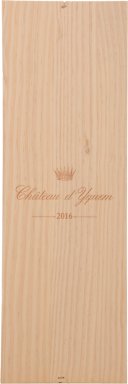Chateau d'Yquem 1er cru superieur
Incredibly opulent and rich, Château d'Yquem is widely considered the greatest sweet wine in the world. Currently owned by LVMH, this prestigious Sauternes estate is at the very top of the appellations classification, designated 1er Cru Classé Supérieur. Château dYquems 110 ha of vineyards are planted to 80% Sémillon and 20% Sauvignon Blanc. The Grand Vin is produced from only fully botrytised fruit, carefully hand-harvested over successive passes by a team of highly skilled pickers. Yields are tiny, with each vine producing just one glass of wine. Fermentation takes place in 100% new oak barriques followed by up to 36 months maturation in oak. A wine of exceptional intensity and complexity, the best vintages of Château d'Yquem are capable of aging gracefully for well over 50 years.
Chateau Cos d'Estournel 2me cru classe
Majestic, intense, full bodied and tannic, Cos dEstournel is considered the leading wine of St Estèphe. Highly tannic in its youth, over time it develops much much like the great wines of adjoining Pauillac. The wine is typically a blend of 60% Cabernet Sauvignon, 38% Merlot and 2% Cabernet Franc, consistently displaying immense power and evident breed.
Château Ausone
Château Cheval-Blanc
Chateau Lafleur
Château Lafleur is a tiny 4.5-hectare Pomerol property located opposite Pétrus and producing wines of comparable quality. It is owned and run by Sylvie and Jacques Guinadeau. While the majority of great Bordeaux châteaux have changed hands over the past several generations, Château Lafleur remains in the same family hands to this day. Its vineyards are situated on the gravel-rich Pomerol plateau and adjoin those of La Fleur-Pétrus. The soils here are particularly deep and are enriched by deposits of potassium and iron. Only natural fertilisers are used and yields are painfully low, even by Pomerol standards. Lafleur's wine is typically a blend of Merlot (50%) and Cabernet Franc (50%). It is aged in small oak barrels (50% new) for 18 months. Wines from Lafleur display a spectacularly intense perfume (partly attributable to the high percentage of Cabernet Franc in the blend) and display layers and layers of concentrated, black fruits, minerals, tobacco spices and creamy liquorice on the palate. The best vintages can last for up to 50 years.
Dom Pérignon Brut Vintage , Gift Boxed (6 )
The Dom Pérignon Brut Vintage 2015 is an exceptional wine for pairing with luxurious, high-end dishes. Its complexity and balance make it an ideal companion to seafood, particularly caviar, king crab, and langoustine. The wine’s delicate profile also complements meats with tangy notes, such as roasted pork, lamb, or duck. For a truly unique experience, try pairing this vintage with exotic fruits like kiwi and guava, or dishes with green curry spices, to accentuate its stimulating complexity. Maker: In 1668, Dom Pierre Pérignon was appointed procurator at the Abbey of Hautvillers. For 47 years, he worked to make the “best wine in the world”. Three centuries later, the Maison Dom Pérignon perpetuates this creative ambition through the constantly renewed quest for harmony as a source of emotion. All creative processes have their constraints. Dom Pérignon’s constraint is the vintage: an ambition to bear witness to the harvest of a single year, whatever the challenges may be, even if it means choosing not to declare the vintage. Dom Pérignon is always an assemblage, forming the foundation of the Dom Pérignon style. It is guided by timeless principles that have always taken precedence over winemaking techniques and their evolution. Time is also part of the equation for Dom Pérignon. During the time of active maturation on the lees, in the darkness of the cellars, the aesthetic and sensory values of each vintage are played out: precision, intensity, touch, minerality, and complexity. Dom Pierre Pérignon's legacy has often been misconceived, overshadowed by myths of inventing Champagne, and even unfounded rumours of blindness. However, what remains true beyond doubt is his extraordinary hard work and dedication to crafting the finest wine in the world. His innovations were groundbreaking. He developed the gentle 'coquard' press, which enabled him to produce clear, still white wine from black grapes. Pérignon also understood the unique challenges of Champagne's marginal climate, pioneering the art of blending grapes from different vineyards to create a more complete and balanced wine. His use of stronger verre anglais ('English glass') bottles, designed to withstand pressure, and the reintroduction of cork as a reliable closure were crucial advancements in winemaking. Through his tireless efforts, Pérignon laid the groundwork for the Champagne and the modern wine world. Philosophy: The philosophy behind Dom Pérignon is one of unwavering commitment to creating Champagne that transcends time, showcasing both the current expression and the potential for future development. Dom Pérignon believes that great Champagne is not simply made—it is born out of nature’s elements and transformed through time, patience, and a deep passion for excellence. With a focus on vintage production, Dom Pérignon captures the essence of each harvest, allowing each bottle to express the unique conditions of the year and the terroir it comes from. The House’s philosophy is reflected in its approach to both blending and aging. Each vintage is crafted to express the duality of fruit and structure, with a delicate balance between power and elegance. The wines are carefully aged to allow them to evolve, with each bottle revealing new dimensions of flavour and complexity as it matures. Dom Pérignon’s philosophy extends beyond just winemaking—it is about creating something that will stand the test of time, an expression of both the present and the future. Tasting Notes Nose Roasted, Floral, Spicy Deep, roasted notes of cacao powder and toasted aromas, gradually unfolding to reveal floral fragrances of lime blossom, jasmine, and peony. A spicy dimension of anise and cardamom adds depth, while a touch of green papaya and orange peel invigorate the overall profile. Palate Broad, Tactile, Generous The wine is broad and tactile, spreading across the tongue with a delicate yet generous texture. Fresh peach, nectarine, and citrus are complemented by sculpted bitter notes of citrus and gentian, creating a harmonious and balanced tasting experience. Finish Fresh, Balanced, Long The finish is long and smooth, with a lingering sweetness that ties together the bright, fresh fruit and the subtle bitterness. The wine’s vibrant acidity and finely textured tannins leave a lasting, memorable impression. The 2015 Dom Pérignon is terrific. Bright and poised, the 2015 shows terrific energy. Citrus peel, white flowers, mint, white pepper and slate all race across the palate. There's gorgeous tension and backbone here, with bright saline notes that extend the mid-palate and finish. This is a fine showing in a vintage that has proven to be tricky. I am intrigued to see how the 2015 develops in the coming years. 2025-2045. - Antonio Galloni (03/2024), Vinous, 96 Points. Disgorged in January 2023, the 2015 Dom Pérignon shows a singular, ethereal profile with aromas of white pepper, iodine, ripe orchard fruits, toast, smoke, herbs and spices. Medium to full-bodied, layered, and structured, it’s enveloping and round with a delicate phenolic mid-palate that underlines chalky dry extracts, concluding with a sapid, penetrating finish with gastronomic bitterness. This iteration of Dom Pérignon, though replete with the customary charm and vinous generosity that typify the label, distinguishes itself by its structural delicate austerity and a notably phenolic profile, giving rise to a remarkably linear and well-defined style that diverges markedly from the more familiar expressions of Dom Pérignon. - Yohan Castaing (05/2024), Wine Advocate, 95 Points. Remarkably pale at this early stage in the glass, the nose hits Dom Pérignon's classic gunsmoke and flint notes together with sweet and bright citrus. Packed with silky ripe fruits on both nose and palate, this is approachable now. Notes of fresh mint and fresh bread dough add to the layers on the palate, which has a creamy mousse but well-defined and vibrant acidity. Chalky in texture on the finish, this is ready to drink but will doubtless evolve well in bottle for over a decade. - Thomas Parker MW (07/2024), 94 Points.
Laurent Ponsot Grand Cru Cuvée du Saule
LAURENT PONSOT Grand Cru Cuvée du Saule , Griotte-Chambertin
Pol Roger Reserve Brut Non-Vintage ( )
Now this half bottle is handy if you wish to toast yourself. Pol Roger is one of the world's power house champagne houses. Famously quoted by the likes of Winston Churchill and the champagne of choice for Her Majesty the Queen. An equal blend of chardonnay, pinot noir and pinot meunier, with addition of 20% reserve wines. It is impressively fresh and vivacious with more depth than most aperitif styles.
Chateau Ausone 1er grand cru classe (A)
Though it has never been absolutely proven, Chateau Asone is rumoured to be the 4th century home of a Roman villa belonging to the classical poet Ausonius - and indeed, part of the estate does contain archaeological remains of a Roman villa. Needless to say, it’s a local estate of great pedigree and despite its incredibly lengthy history, it has only changed familial hands three times, culminating in the 17th century with the Dubois-Challon-Vauthier family, in whose descendents hands it remains today. Widely regarded among Bordeaux winemakers to be home to some of the best terroir in the region and that terroir, along with the skilled hand of Alain Vauthier, have made it one of the best producers of Bordeaux wine in the world. Renowned for its unique flavour and rich, full-bodied minerality, the 2016 has been lauded for its “regal” yet “stunning and ethereal” character, and widely regarded as one of THE wines of this year’s vintage.




































